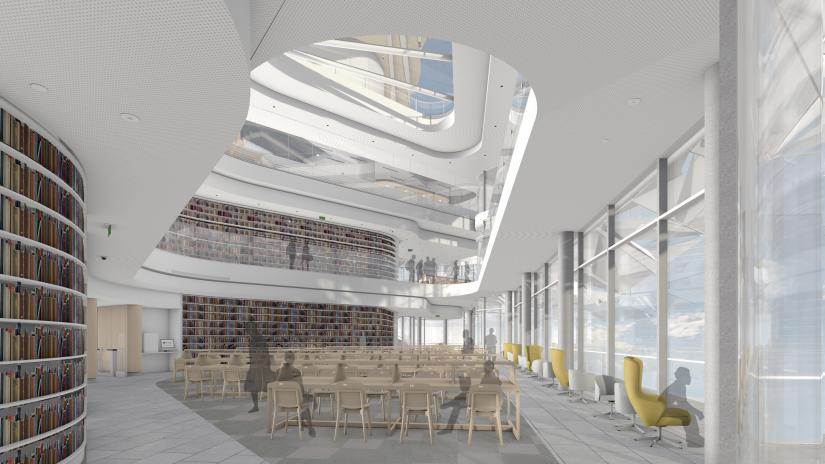UTS Central by the numbers
December 2018
There’s no doubt that UTS Central is making a huge impression on our campus landscape. But what goes into the design and construction of such a mammoth building? Let’s break it down.
About the size of it
With around 32,400sqm of floor space over 17 levels, UTS Central will be a similar size to the neighbouring Engineering and IT building (Building 11) and the Fairfax building (Building 10). With its 27 floors, it’s probably no surprise that the Tower is the largest campus building, with a colossal 63,500sqm.

UTS Central is set to become the second biggest building on campus, after the Tower.
The UTS Central lower podium levels will house three high-tech collaborative theatres featuring multiple presentation positions. The two 350-seat theatres will be some of the largest on campus while the third is a still-impressive 198 seats. In the basement, a Science Super Lab will be the building’s single biggest space, with room for 270 students, beating the Vicki Sara building’s (Building 7) Super Lab for size. Students will have their choice of learning commons and informal study areas, including 27 group study spaces.
Ins and outs
Five – that’s the number of external entry points to UTS Central, with the main public entry leading from Jones St into the building’s foyer level 4, which features areas for informal learning plus a showcase space for exhibitions. Level 4 access is also available from Alumni Green and Broadway, while two entries from Alumni Green will give direct access to the level 3 food court for the hordes of staff and students looking to refuel or recaffeinate.
Four connections on levels 3–6 will link UTS Central directly to the UTS Tower (Building 1) next door. A future connection on level 2 is also likely.
Ups and downs
Stairs are a key design feature in UTS Central. In all, there are 19 stairways, with a total of 1648 steps – more than enough to keep all fitness fans happy. Health is just one benefit. Stairs also encourage informal connections as staff and students come across each other on their way to work or study.

A double helix stair is a feature of the level 4 lobby.
The showpiece is a double helix stairway that connects the level 4 entry with levels 5, 6 and 7. It has 176 steps in all, while the other most notable stairs – serving the eight-level winter garden and the three-level Reading Room – have 144 and 60 steps respectively. The longest flight of stairs is a fire stair that begins in the lift lobby and has 614 steps. Don’t do stairs? Eight lifts and 12 flights of escalators (six ascending and six descending) serve the podium levels, with five lifts continuing up to the tower floors.
Figures for foodies
Those eager for more casual dining options on campus might already know that there will be eight different food outlets – including a restaurant/café – in UTS Central’s level 3 food court, offering various authentic cuisines as well as budget-friendly and healthy menu options.

The new UTS Central food court will offer eight different food outlets and plenty of seating.
Kebabs, burgers, Thai? We’ll let you know as soon as the food outlets are confirmed. The food court will also offer around 440 seats – inside and outside – and, in fine weather, who wouldn’t want to spill out of the food court onto Alumni Green for an impromptu picnic?
An additional coffee cart will operate outside the level 7 entrance to the UTS Library – handy for students who need a coffee hit before they get down to some serious study.
On the right page
The new UTS Library, which will extend over three floors (levels 7–9) in UTS Central – plus a staff workspace on level 10 – is expected to house around 120,000 books by the time it opens in late 2019. Of course, this is a just a small fraction of the entire collection, with almost 70% – or around 500,000 lesser-used items – now stored in the vast Library Retrieval System located under Alumni Green, which will connect directly to the UTS Library via a books lift.
Overlooking Alumni Green, UTS Central’s scholarly Reading Room will hold a further 5000 reference books on levels 5 and 6.

UTS Central's scholarly Reading Room will hold around 5000 books.
A very big build
A typical day on the construction site might see around 380 workers on site – rising to an army of about 430 on some days. When it comes to materials, the 159-week project has thrown up some fascinating numbers, including that 6400 tonnes of bricks from the demolished Building 2 were removed. Around 20,000 cubic metres of concrete has been used during construction, along with nearly a kilometre of steel beams. In fact, the combined mass of steel and concrete used to construct temporary beams (used on level 4 while structural strengthening works were carried out) was in excess of 600 tonnes – comparable to the take-off weight of the long-haul Airbus A380. As for the glass façade, it consists of around 3600 glass pieces, the largest measuring 6 x 2.3m, and the heaviest weighing in at around 700kg.
But perhaps the most important number of all is the year the building will be completed – and that’s 2019. Entry levels 3 and 4 are expected to open mid-year, with other floors coming online progressively through to early 2020.
